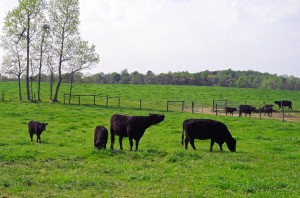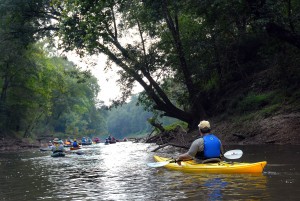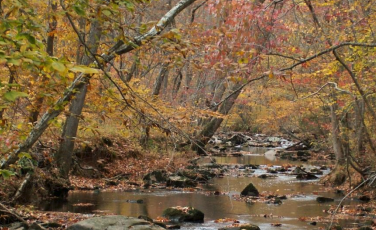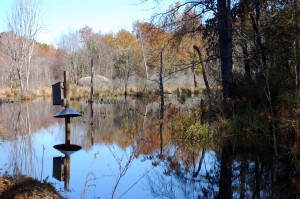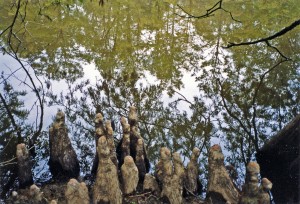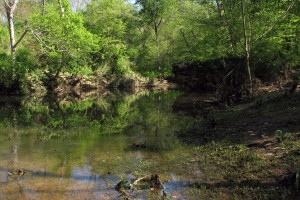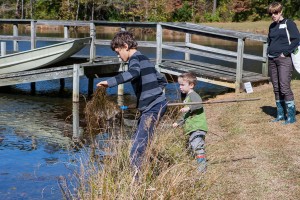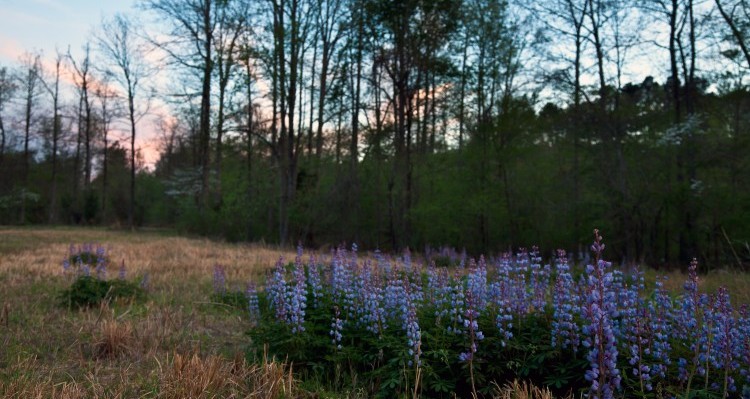
Wild Perennial Lupine bloomed on land near Mark’s Creek, North Carolina.
TLC has identified specific landscapes in the region as Conservation Initiatives to focus our conservation efforts: Chatham County Working Lands, Deep River, Eno-New Hope Landscape Conservation Plan, Johnston County Farmland, Jordan Lake One Water, Marks Creek, Neuse River Lowgrounds , New Hope Creek, and the Upper Neuse Clean Water Initiative. These special areas provide the region with important benefits such as conserved land, including clean water, natural habitats, local farms and food, and places to connect with nature.
In addition to our Targeted Initiatives, TLC is making significant conservation efforts in special project areas along the Haw and Rocky Rivers.
Jordan Lake One Water (JLOW)
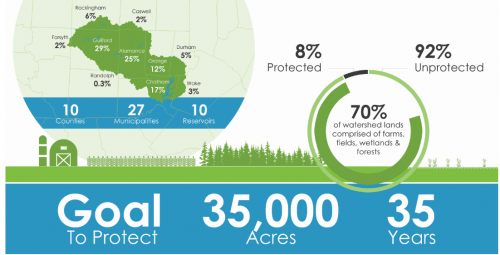 One of the most effective ways to protect drinking water sources is to conserve the upstream land, streams, and creeks. Forests, wetlands, and open fields slow down rain and run allowing water time to gradually filter really through the soil. This Jordan Lake Watershed Conservation Strategy provides a framework for protecting drinking water supply resources through land protection.
One of the most effective ways to protect drinking water sources is to conserve the upstream land, streams, and creeks. Forests, wetlands, and open fields slow down rain and run allowing water time to gradually filter really through the soil. This Jordan Lake Watershed Conservation Strategy provides a framework for protecting drinking water supply resources through land protection.
During 2018-2019, JLOW partners and stakeholders undertook a planning process to design a land conservation strategy using the best available science and geographic data to identify land protection priorities. The results in an enhanced Geographic Information Systems (GIS)-based Watershed Protection Model that spatially identifies prioritized locations to invest in land conservation.
Jordan Lake Watershed Conservation Strategy
Chatham County Working Lands
A farming community in northwestern Chatham County has supported the growing Triangle and Triad for over 100 years. Around the Silk Hope area, you will find both fifth- and first-generation farmers, young and old, as well as those producing for large and small markets. This land attracts both farmers and non-farmers because of its prime soils, agricultural infrastructure, scenic views, location, history, and, most importantly, a strong community supportive of the farming tradition. TLC works with local livestock growers, dairies, and vegetable producers to conserve this critical farmland through a variety of conservation tools, including conservation easements. Our goal is to conserve over 1,500 acres of farmland in the area.
Our Goal: Protect the agricultural community, soil, water resources and economic viability of farmers and farmlands in western Chatham County.
Significance of the Chatham County Working Lands
- Long-established agricultural community
- Identified as a priority conservation area in the Triangle GreenPrint and Chatham County Farmland Protection Plan
- Home to some of the best agricultural soils in the region
A Comprehensive Conservation Plan for Chatham County, North Carolina, 2011 (PDF)
Deep River
Chatham and Lee Counties
Along the Deep River, natural treasures and historic troves lie in hiding. You feel the water’s unexpected power in a canoe and see the landscape’s beauty. The endangered Cape Fear shiner swims quietly below the surface, a small golden minnow. White pine trees, remnants from the last Ice Age, adorn the riverside slopes. The remains of a lock, dam, and canal at Lockwood tell of a complex but failed river navigation system. Near Cumnock, you can almost hear the whispers of the many men who gave their lives in the bowels of old coal mines, lost in the hot pursuit of fortune.
The Deep River has rarely attracted much attention or kept long, which is precisely why these treasures still exist today. However, the river now feels the impacts of the region’s burgeoning population. The Deep River is an important water supply for Chatham and Lee counties, but nutrients like phosphorus and nitrogen and mud and sediment degrade the river’s water quality. The time is now to protect the Deep River so its natural and human history will not be lost to us or future generations.
Our Goal: Protect key water quality sites, nature areas, scenic vistas, historic sites, and potential recreation sites while advocating for parkland acquisitions for the Deep River State Park and the creation of future canoe access points.
Learn more about this initiative and read the Deep and Rocky Conservation Plan here.
Significance of the Deep River
- Critical aquatic habitat for a plethora of rare and endangered fish and mussel species, like the Cape Fear shiner
- Drinking water supply for Chatham and Lee counties and downstream communities
- A multitude of unique, diverse historic sites
- A wealth of fragile and precious natural areas
Conservation Assessment for the Lower Deep and Upper Cape Fear River, 2001 (PDF)
Eno-New Hope Landscape Conservation Plan
Chatham, Durham, Orange, and Wake counties
The Eno-New Hope Landscape Conservation Plan focuses on the critical importance of habitat connectivity for wildlife in the Eno River and New Hope Creek watersheds in Chatham, Durham, Orange, and Wake counties.
It was produced by a collaboration among local governments, conservation groups, universities, and ecologists. The Landscape Plan is a Partners for Green Growth project funded by the North Carolina Wildlife Resources Commission and Orange County, NC, and administered by the North Carolina Botanical Garden Foundation, Inc.
Eno-New Hope Landscape Conservation Plan
Johnston County Farmland
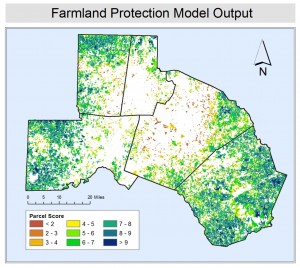 Johnston County has a rich cultural history rooted in agriculture dating back to pre-colonial times. Present-day Johnston County is the tenth largest county by land area in the state and is comprised of a diverse landscape dominated by agricultural land, forestland, and expanding urban centers. These working lands provide agricultural opportunities, ecotourism, local jobs, and community businesses. Farm and forestlands also provide important food and cover for wildlife and help to control flooding, conserve watershed functions, and maintain air quality. Like undisturbed natural communities, working lands also absorb rainfall, filter wastewater, and urban runoff, and recharge groundwater supplies.
Johnston County has a rich cultural history rooted in agriculture dating back to pre-colonial times. Present-day Johnston County is the tenth largest county by land area in the state and is comprised of a diverse landscape dominated by agricultural land, forestland, and expanding urban centers. These working lands provide agricultural opportunities, ecotourism, local jobs, and community businesses. Farm and forestlands also provide important food and cover for wildlife and help to control flooding, conserve watershed functions, and maintain air quality. Like undisturbed natural communities, working lands also absorb rainfall, filter wastewater, and urban runoff, and recharge groundwater supplies.
Population growth poses a serious challenge to the future of agriculture in Johnston County. The county’s population is expected to increase by 16.2% from 2010 to 2020 and then grow by an additional 13.7% between 2020 and 2030, making it one of the fastest-growing counties in the entire state.
As part of this initiative, TLC has been working with the Conservation Trust for North Carolina (CTNC) on an agricultural mapping study to identify the highest priority farmlands in the Triangle region (see inset map). Within the five-county region, Johnston County stands out in preliminary mapping as having some of the highest value farmlands. Most of Johnston County and regions of western Chatham County, where TLC has another ongoing farmland protection effort, rank highly in comparison to other areas of the Triangle.
Our Goal: Expand conservation efforts in Johnston County with a specific focus on farm and forest land protection through easements.
Significance of Farmlands in Johnston County:
- Johnston County ranks second in the state for vegetable production
- Many Johnston County farms supply vegetables to the State and other local markets
- Agriculture and the associated agribusinesses contribute over $3 billion value-added annually to the local economy
Marks Creek
Wake and Johnston Counties, near Raleigh and Clayton
A quiet community slumbers in an apparent time-warp on Marks Creek and the Neuse River, only 10 miles from the bustling state capital, Raleigh. Historic homes and farms, old barns, pastures and fields, country stores, ponds, wetlands, forests, and rural churches line the roads. The 19th-century Oaky Grove Methodist Church stands sentinel on the edge of a rolling horse pasture, shaded by a lone oak. Glistening in the sun, Lake Myra, an old mill pond turned 1930s recreation lake, beckons drivers-by to jump in a boat and fish.
But, this place is even more extraordinary because so much of its value lies hidden from the roads. The Marks Creek watershed includes an undeveloped area of more than 7,500 acres in size; it has the potential to be a vast natural park, more prominent than Umstead State Park.
Time is running out. Several nearby highway projects promise more growth in this area and a rude awakening back to the 21st century, so much so that Scenic America named Marks Creek a ‘Last Chance Landscape’ in 2003. TLC is catalyzing the protection of Marks Creek and the surrounding rural landscape. We are convening a host of partners, including state, county, and municipal governments to take this “last chance” to preserve Marks Creek before the time-warp ends.
Our Goals:
- Protect the significant wetlands, natural areas, scenic vistas, farms, and historic sites of the Marks Creek watershed
- Connect communities in the region through wildlife corridors and recreation trails, including sites for the Mountains-to-Sea Trail and spur trails
- Preserve the scenic views along Marks Creek and the Neuse River
Significance of Marks Creek
- Important historic sites on the National Register of Historic Places
- Active farmland and scenic rural vistas
- A 7,500-acre undeveloped area in the heart of the watershed
A Conservation Assessment for the Neuse River and Mark’s Creek, 2001 (PDF)
Neuse River Mark’s Creek 2008 Conservation Plan Update (PDF)
Marks Creek Conservation Assessment Maps
Neuse River Lowgrounds
South of Smithfield, the Neuse River spreads into a mysterious swampy quagmire known as the “Let’Lones”. Thought to be filled with venomous snakes and plants, quicksand, and bottomless ponds, folks were advised simply to stay away, leave it alone, hence, the name Let’Lones.
A vast floodplain four miles wide, the Let’Lones, or as we call them, the Lowgrounds, is, in reality, one of the most extraordinary wilderness areas in the southeast, completely undeveloped and roadless for 72 square miles, or 36,000 acres. Full of wetlands, sloughs, levees, and extensive mature cypress forests, it is the largest contiguous piece of undeveloped land in this part of the state. As such, it is exceptional wildlife habitat for neotropical birds, fox squirrel, black bear, coyote, bobcat, and other rarities. It is also critical to communities downstream on the Neuse River because the massive floodplain is so effective at filtering impurities from the Triangle’s urban stormwater.
The State has identified the Lowgrounds as a location for a new state park, but clearcutting has decimated considerable acreage throughout the area, making action imperative.
Our Goal: Protect the unique natural areas and critical sites for water quality protection and work with the NC Division of Parks and Recreation to establish a state park in the area.
Significance of the Neuse River Lowgrounds
- Wide floodplain and wetland expanse, critical for filtering pollutants from the Neuse River
- Unique fluvial formations, like oxbows and sloughs
- Extensive, mature forests and extraordinary wildlife habitat
- Inimitable opportunity for large-scale wilderness protection
New Hope Creek
Orange and Durham Counties between Chapel Hill and Durham
On the edge of two of the fastest-growing cities in North Carolina, New Hope Creek is a gift of nature within an hour’s drive of a million people. In its upper reaches north of Chapel Hill, New Hope tumbles like a rugged mountain stream, boulder-strewn and wild, twisting below rock bluffs and snaking through a narrow valley in Duke Forest. Below, the lower New Hope changes character abruptly. There, in the highly developed corridor between Durham and Chapel Hill, New Hope becomes a lazy floodplain stream meandering its way south to Jordan Lake, the drinking water supply for thousands of Triangle residents.
Miraculously, New Hope remains clean and forested for almost its entire length, a haven for hikers and wildlife, even as it winds between the two towns’ shopping centers, offices, and subdivisions. It will stay this way only through concerted public and private actions.
Our Goals:
- Protect a linked green corridor between Duke Forest and Jordan Lake
- Help our partners create over 18 miles of trail along New Hope Creek and its tributaries from Chapel Hill to Duke Forest to Jordan Lake
- Protect New Hope’s headwaters, from TLC’s Steep Bottom Preserve to Johnston Mill Nature Preserve
Significance of New Hope Creek
- Primary tributary of Jordan Lake, a regional drinking water supply
- One of the most important wildlife habitats in the Triangle, home to hundreds of plant and animal species that are quickly disappearing in these parts
- Discovery grounds for hundreds of families, who explore the creek via the trails at Johnston Mill Nature Preserve, Duke Forest, and Githens Middle School
New Hope Creek Master Plan, 1991 (PDF)
Upper Neuse Clean Water Initiative
Durham, Northern Orange, and Wake Counties
The Upper Neuse Clean Water Initiative (UNCWI) is a partnership effort to prioritize and protect those lands most critical for the long-term safety and health of all drinking water supplies for the communities in the Upper Neuse River Basin. In addition to providing our community with clean water, land in this region is also known for working farmland and the gorgeous rolling beauty of the surrounding countryside.
The Initiative brings together landowners, conservation organizations, and local and state government programs in the Upper Neuse River Basin to protect Falls Lake, Lake Michie, Little River Reservoir, Lake Holt, Lake Orange, New Hillsborough Lake, Corporation Lake, Lake Ben Johnston, and Lake Rogers. Initiative partners work with landowners, local governments, and the public to review land conservation options and acquire key parcels of land through voluntary purchase or donation of land or conservation agreements.
Generous support is provided by North Carolina’s natural resources trust funds; the City of Raleigh; Wake, Durham and Orange counties; and other government funding partners across the basin.
Our Goal: Conserve land along streams and tributaries to safeguard clean water for our community and preserve the scenic beauty and important farmlands of the region through conservation easements.
Significance of the Upper Neuse Clean Water Initiative
- Regional drinking water supply for nearly half a million Triangle residents
- Critical aquatic habitat for five rare mussel species
- Surrounded by important farmland and stunningly beautiful countryside
Learn more about UNCWI and read the UNCWI Conservation Plan
Upstream Matters! TLC is one of several organizations in a coalition working to ensure clean water for Raleigh and the Triangle. Learn more.

